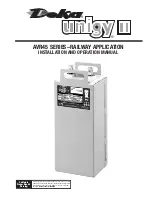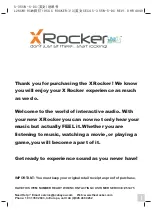
Battery Operation
continued
Discharging at temperatures less than 77°F (25°C) will reduce
the capacity of the battery and require longer charging time to
become fully charged.
If operating temperatures are
expected to be less than 50°F (10°C) contact East Penn
for trecommendations.
The battery string must be located in a manner that the individual
cells do not vary by more than 5°F (2.8°C) between the
lowest and highest individual cell temperature.
Rectifier Ripple Voltage
FREQUENCY
Ripple that has a frequency greater than 667Hz (duration
less than 1.5ms) is acceptable, unless it is causing additional
cell heating.
Ripple that has a frequency less than 667Hz (duration greater
than 1.5ms), must meet the following voltage specification to
be acceptable.
VOLTAGE
Ripple voltage shall be less than 0.5% peak to peak (0.177%
rms) of the manufacturer’s recommended battery string voltage.
Failure to comply can void the warranty.
RECORD KEEPING
Voltages, Temperatures & Ohmic Readings
Record keeping is an important part of stationary battery main-
tenance and warranty coverage. This information will help in
establishing a life history of the battery string and inform the
user if and when corrective action needs to be taken.
All measuring equipment should be in good operating condition
and accuracy should be confirmed on an annual basis to NIST
traceable standards.
After installation and when the battery string has been
on float charge for one week, the data as detailed in
the “Maintenance Section” should be recorded. Battery
Maintenance Report worksheet provided in Appendix E.
Failure to maintain proper records including information as
detailed below may result in voiding any applicable warranty.
Acceptance Testing
Each cell should be at 100% State of Charge prior to performing
an acceptance test on the battery system. To ensure the cells are
fully charged the following charge schedule should be followed.
Cells should be charged at the equalization rate of 2.40 volts per
cell for 24 hours. Temperature compensated charging parame-
ters shall be applied as detailed in “Temperature Compensation”
in Appendix C of this manual.
To ensure the cells are fully charged within 24hrs; the charger
used for this charge must have the current equal to the maxi-
mum charge current for the given cell type (model), as called out
in Appendix B
If these requirements cannot be met, contact East Penn Reserve
Power’s Product Support group for alternate instructions.
Upon completion, the charge voltage should be lowered to the float
voltage of 2.25 volts per cell for a minimum period of 72 hours.
Reference: IEEE 1188-2005 Section 7.2 for additional acceptance
test requirements.
Upon completion of the above charge, the desired acceptance test
can be performed.
NOTE:
There shall be no discharges of any duration between the
start of the equalization and the completion of the float period. If
a discharge does occur, the charging regime detailed above shall
be repeated.
6
Upon completion of the acceptance test, the battery system
should be placed on float charge at 2.25 volts per cell to restore
the battery to its’ rated capacity.
Batteries should not require an equalization charge once they
have passed their initial acceptance test. Consult with East Penn
Reserve Power Product Support Department before performing
additional equalizing charges on batteries that have successfully
passed their initial acceptance test.
MAINTENANCE
Always wear eye protection when working on or near batteries.
Keep sparks and open flames away from batteries at all times.
See Safety Precautions on pg. 3.
Annual Inspection
(1)
1. Conduct a visual inspection of each cell.
2. Record the battery string voltage.
3. Record the charger voltage.
4. Record the individual cell voltages. The accuracy of the DMM
(Digital Multimeter) must be .05% (on dc scale) or better. The
DMM must be calibrated to NIST traceable standards. Because
float readings are affected by dis¬charges and recharges,
these readings must be taken when batteries have been on
continuous, uninterrupted float for at least one month. Cells
should be within ± 0.05 volts of the average cell float voltage.
5. Record the ambient temperatures.
6. Record individual cell ohmic readings.
7. Record all intercell, interunit, and terminal connection
resistances. Micro-ohm readings should be taken during
this inspection. If any reading differs by more than 20%
from initial readings taken, retorque the connection.
Recheck the micro-ohm reading. If the reading remains
high, clean the contact surface according to installation
portion of this manual.
(1)
Other maintenance inspection intervals follow IEEE 1188
Battery Cleaning
1. Disconnect battery system from power source.
2. Dust accumulation can be removed with cloth dampened with
clean water.
3. Corrosion buildup should be neutralized using a mixture of
baking soda and water or East Penn Mfg supplied battery
cleaner (part # 00321).
4. Use cloth dampened with clean water to remove residue.
Never use solvents to clean the battery.
Capacity Testing
Per
IEEE 1188
“Capacity testing is used to trend battery aging.
The result of a capacity test is a calculation of the capacity of the
battery. The calculated capacity is also used to determine if the
battery requires replacement”.
When performing capacity testing and recording data refer to IEEE
1188 recommendations.
NOTE: When discharging at higher rates, extra connectors
may be needed to be added to prevent excessive voltage drop
and / or excessive temperature rise.
Should it be determined that and battery(ies) need to be replaced
contact your nearest East Penn agent or East Penn Service Center.
Summary of Contents for Unigy II AVR45 Series
Page 11: ...APPENDIX E 11 ...






























